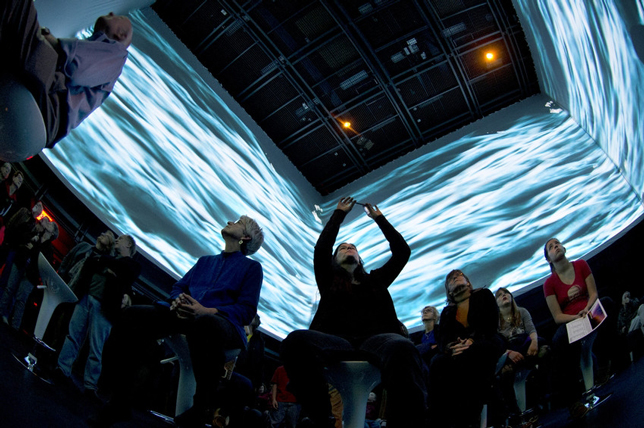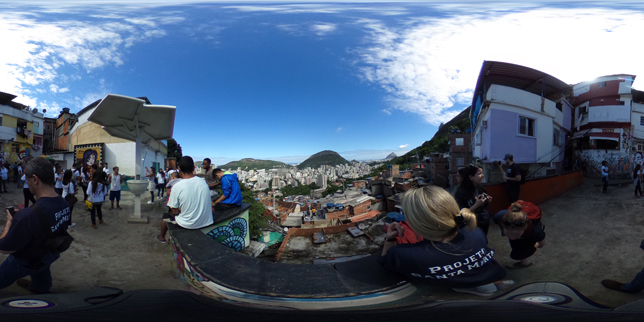Guiding Faculty into Immersive Environments
What's the best way to get faculty to engage with emerging technologies and incorporate new learning spaces into their teaching? Five institutions share their experiences.
In 2015, Virginia Polytechnic Institute and State University's Institute for Creativity, Arts and Technology (ICAT) launched the Cube, an adaptable space for research and experimentation housed in the campus's Moss Arts Center.
One of the first things ICAT did was to hire an immersive environment specialist to help faculty members who were incorporating the new space into their curricula.
"I remember Ben Knapp, ICAT's director, used the term 'concierge' when he came up with the position," recalled Zach Duer, who served in the job for a year and a half before becoming an assistant professor in the school of visual arts. "That's because he envisioned multiple levels of service. Someone could come in just needing to hook up a video and I could help them do that," Duer said, "or they could come in with a full project that is going to take two years to develop and I could help them with that, too."
According to Duer, it's a common problem that universities invest in new technologies such as immersive learning spaces but fail to create positions like his to help faculty learn how to use them. "Before I worked here, there was a constant problem of reinventing the wheel because one project would come up with something that would work in the Cube, and they would use it for that project, and then the next group would come in and have to do the same thing," he said. "Part of my job was to become a centralized resource to help make tools and then turn them into publicly available resources."

Virginia Tech's Cube space (Photo: courtesy of Virginia Tech)
Colleges and universities face several hurdles in getting faculty to incorporate virtual reality or immersive experiences in their courses. For one, instructional designers, instructional technologists and directors of teaching and learning centers may not have access to these tools yet, and the budgets aren't always there to get the labs off the ground, noted Daniel Christian, instructional services director at Western Michigan University's Cooley Law School. "Many faculty members' job plates are already jam-packed — allowing little time to even look at emerging technologies," he said. "Even if they wanted to experiment with such technologies and potential learning experiences, they don't have the time to do so. Tight budgets are impacting this situation even further."
Coffee and Visualization
Leaders of other immersive environment labs describe finding creative ways to engage faculty members. Mike Nutt, director of visualization services at North Carolina State University's Hunt Library, works to entice faculty into that facility's Teaching and Visualization Lab, which has a 270-degree wrap-around screen.
"Not every faculty member can walk into that room and immediately understand what they should use a huge screen like that for or how that is different from the PowerPoint they are used to creating," he said. "We try to get them in the door. We try to lower the barrier the entry."
The library has created a seminar series where faculty members come to watch a visualization-focused talk in that space. Nutt also created a series of "Coffee & Viz" events to foster a community around visualization. "Coffee lubricates the social interactions," Nutt says. "That has been a runaway success. I can't imagine having a space like that without a program like Coffee & Viz attached to it."
Measuring Impact
Penn State University has a number of immersive spaces across its many campuses. Its Teaching and Learning with Technology group offers centralized support for faculty interested in VR and immersive displays. But there is also local support for faculty in particular colleges.
One of the oldest such spaces on PSU's main campus is the Immersive Environments Lab in the Stuckeman School of Architecture and Landscape Architecture. "Many faculty members use the large-scale immersive display in 3D and it is fairly well integrated into the curriculum," said lab coordinator Danielle Oprean. Faculty members are learning how to integrate the environment with 3D objects they design and create in makerspaces, she added.
For instance, professor José Pinto Duarte has created an immersive space for studying urban design, with a focus on Rio de Janeiro's informal hillside communities known as favelas. "It is dangerous to travel there most of the time," he explained. "So our idea was to use 360-degree photography and videos to create digital models of the favelas and have students use the VR environment as if they were going on a site visit."

In Penn State's Immersive Environment Lab, 360-degree photos and videos allow students to "visit" Rio de Janeiro's favelas in virtual reality. (Photo: Jose Pinto Duarte, Penn State)
In another example, Alexander Klippel, a PSU professor of geography, founded a "ChoroPhronesis Lab" that uses advanced geospatial technologies, from 3D modeling to the full range of immersive technologies. He stressed the importance of measuring the impact of immersive environments on learning outcomes. "There is a lot of 'wow factor' about the technology, but what we have seen in the past is that it has not necessarily translated into learning success," he said.
A large geosciences introductory course at PSU studied the learning outcome differences between students who went on a field trip to a site vs. those who experienced it in a virtual environment. Researchers are writing a paper on the experiment, with results seeming to favor the immersive experience. "It may be that the technology helps you understand a place in a way that is not possible when you are right there," Klippel said.
Affordability
One of the biggest hurdles for universities has been the high cost of VR-enabled computers and headsets, and some executives say prices must continue to drop before we'll see more widespread usage. But John Bowditch, director of the Game Research and Immersive Design Lab at Ohio University's Scripps College of Communication, is already seeing promising developments on that front as he prepares to open a new 20-seat VR classroom. "Probably the best thing about VR in 2018 is that it is a lot more affordable now and that democratizes it," he said. "We purchased a VR helmet 13 years ago, and it was $12,000 just for the headset. The machine that ran it cost about $20,000. That would be a nonstarter beyond purchasing just one or two. Today, you can get a VR-enabled laptop and headset for under $2,000. That makes it much easier to think about integrating it into classes."